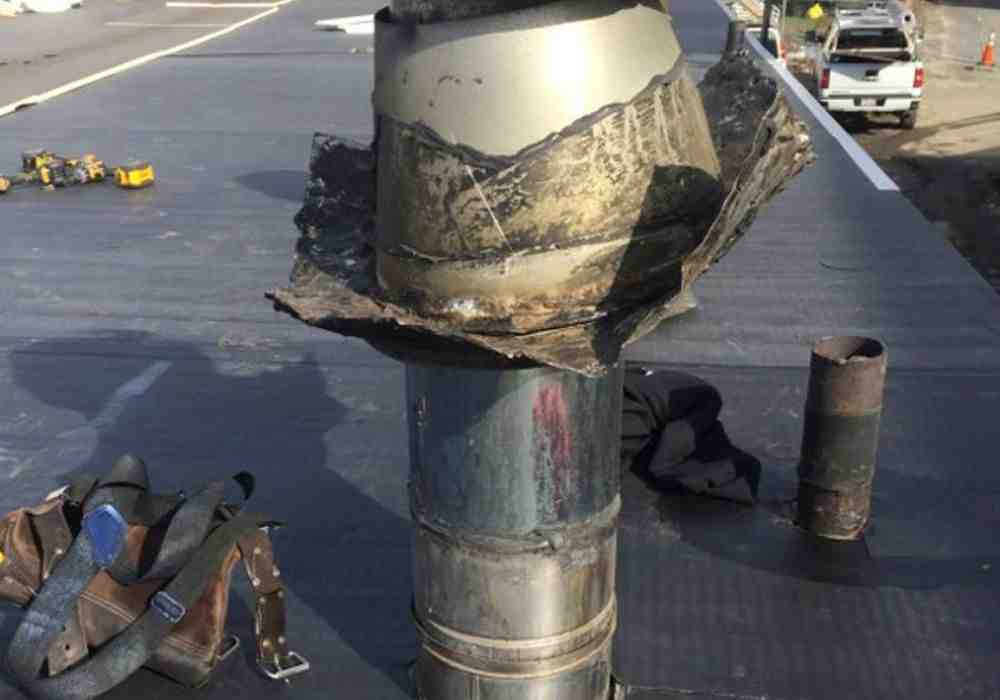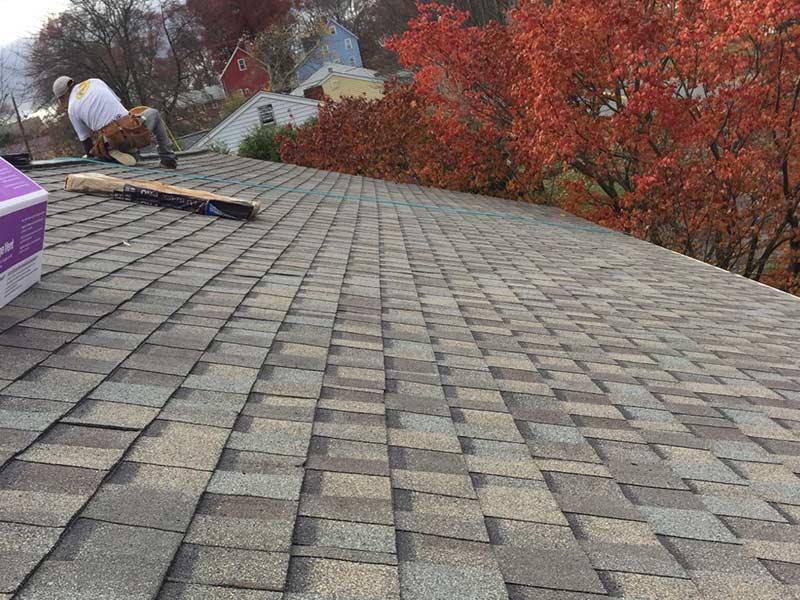Why Roof Replacements Are Important
Roof replacements are a crucial investment for any homeowner. Over time, roofs naturally wear and tear due to weather conditions and age. Recognizing the signs of wear, such as leaks, missing shingles, and moss growth, can help you decide when it’s time to replace your roof. Ensuring you hire a qualified roofer guarantees that your new roof will be installed correctly, providing long-term protection for your home.
Key points to consider:
– Roof lifespan: Most roofs last between 20-25 years.
– Signs of wear: Look for leaks, missing shingles, and visible damage.
– Quality of roofer: Skilled professionals ensure the job is done right.
I’m Kevin McLaughlin, the owner of Heritage Exteriors LLC. With over a lifetime of experience in the home improvement industry, I specialize in roof replacements and understand what it takes to deliver high-quality results. Now, let’s dive into how you can find the best roof replacement options.

Step 1: Assess Your Roof’s Condition
Before diving into roof replacements, it’s crucial to assess your roof’s current condition. This step will help you understand whether you need a full replacement or just some repairs. Here’s how you can do it:
Common Signs Your Roof Needs Replacement
Start with a thorough roof inspection. Look for visible signs of damage both inside and outside your home. While a professional inspection is always recommended, you can begin with a basic assessment yourself.
Leaks
One of the most obvious signs that your roof needs attention is leaks. Water stains on your ceilings or walls often indicate that your roof’s protective barriers have been compromised. Persistent leaks can lead to severe damage, so addressing them promptly is crucial.
Missing Shingles
Shingles protect your roof from the elements. If you notice missing shingles or find pieces of shingles in your yard, it’s a sign that your roof is deteriorating and might need replacement. Missing shingles can expose the underlying structure to water and wind damage.
Moss and Mold
Moss and mold growth on your roof surface can be more than just an eyesore. They often indicate excessive moisture and potential decay. While cleaning the affected area might provide a temporary solution, a new roof may be necessary for a long-lasting fix.
Flashing Issues
Flashing is the material placed around roof features like chimneys and vents to prevent water from seeping in. Damaged or corroded flashing can lead to leaks and water damage. Check these areas carefully during your inspection.
Lifespan Indicators
Most roofs have a lifespan of 20-25 years. If your roof is approaching this age, it’s wise to consider a replacement even if it appears to be in decent condition. Older roofs are more susceptible to damage and may not provide adequate protection.
Granules in Gutters
Finding granules in your gutters is normal for a new roof, but excessive granules can signal that your shingles are deteriorating. This loss of granules reduces the roof’s effectiveness in protecting your home.
Sagging Roof Deck
A sagging roof deck is a serious issue that suggests structural damage. This could be due to prolonged water damage, poor installation, or excess weight from multiple layers of roofing materials. Addressing this promptly is essential to avoid further complications.
By understanding these signs and regularly inspecting your roof, you can take proactive steps to maintain your home’s integrity and avoid costly repairs.

Now that you’ve assessed your roof’s condition, it’s time to explore the different roofing materials available for your roof replacement project.
Step 2: Research Roofing Materials
Comparing Roofing Materials
Choosing the right material for your roof replacement is crucial. It impacts the cost, durability, and overall look of your roof. Let’s explore some common options:
Asphalt Shingles
Asphalt shingles are a popular choice for many homeowners. They are cost-effective and come in various styles and colors, making them easy to match with your home’s aesthetic.
- Durability: Typically last 20-30 years.
- Cost: One of the most affordable options.
- Aesthetic Value: Available in many colors and styles.
- Climate Suitability: Suitable for most climates but may need repairs after severe weather.
Metal Roofing
Metal roofing is known for its durability and energy efficiency. It reflects sunlight, helping to reduce cooling costs in the summer.
- Durability: Can last up to 70 years.
- Cost: More expensive upfront but offers long-term savings.
- Aesthetic Value: Available in various styles and colors, including panels and shingles.
- Climate Suitability: Great for hot climates due to its heat-reflective properties. Also ideal for cold climates as it sheds snow and ice easily.
Clay Tiles
Clay tiles offer an aesthetic appeal that many homeowners love. They are particularly beneficial in hot climates as they reflect sunlight and keep homes cooler.
- Durability: Can last up to 50 years or more.
- Cost: More expensive than asphalt but less than slate.
- Aesthetic Value: Provides a classic, Mediterranean look.
- Climate Suitability: Ideal for hot climates but heavy, requiring a strong roof structure.
Concrete Tiles
Concrete tiles are similar to clay tiles but are more affordable and just as durable.
- Durability: Can last up to 50 years.
- Cost: Less expensive than clay tiles.
- Aesthetic Value: Available in various styles and colors.
- Climate Suitability: Suitable for hot climates but also heavy, requiring strong support.
Slate Shingles
Slate shingles are considered a luxury option due to their high cost and neat appearance. They are incredibly durable and can last over 100 years.
- Durability: One of the most durable roofing materials available.
- Cost: Very expensive.
- Aesthetic Value: Offers a distinctive, high-end look.
- Climate Suitability: Suitable for various climates but very heavy, requiring a robust structure.
Synthetic Slate Tiles
Synthetic slate tiles resemble natural slate but are lighter and less prone to damage.
- Durability: Can last up to 50 years.
- Cost: Less expensive than natural slate.
- Aesthetic Value: Mimics the look of natural slate.
- Climate Suitability: Suitable for most climates and lighter than natural slate, reducing structural concerns.
Durability, Cost, Aesthetic Value, and Climate Suitability
When choosing a roofing material, consider these factors:
- Durability: How long will the material last? More durable materials like metal and slate may cost more initially but offer long-term savings.
- Cost: What’s your budget? Asphalt shingles are the most cost-effective, while slate and metal can be more expensive.
- Aesthetic Value: How do you want your home to look? Each material offers different styles and colors.
- Climate Suitability: What’s your local climate like? Metal roofs are great for hot and cold climates, while clay tiles are ideal for hot regions.
By comparing these factors, you can make an informed decision about the best material for your roof replacement.
Next, we’ll explore how to get multiple quotes for your roofing project.
Step 3: Get Multiple Quotes
When planning a roof replacement, it’s crucial to get multiple quotes. This helps you compare costs and services, ensuring you get the best value.
What to Include in a Roofing Quote
A detailed roofing quote should cover several key areas. Here’s what to look for:
- Cost Estimates: The quote should break down costs for materials, labor, and any additional expenses. Look for transparency in pricing to avoid hidden fees.
- Labor Costs: Labor can account for about 60% of the total cost. The quote should detail the number of workers, their experience, and the estimated hours required.
- Material Costs: Different materials have different costs. Ensure the quote specifies the type of roofing material, underlayment, flashing, and sealants. For example, asphalt shingles are cheaper than metal or slate tiles.
- Permit Requirements: Some roofing projects require permits. The quote should include the cost of obtaining these permits. Permits can add several hundred dollars to your expenses, depending on the job’s scale.
- Material Type: The quote should clearly state the type of roofing material being used. This ensures you know exactly what you’re paying for and can compare it with other quotes.
- Project Timeline: Time is money. A good quote will include an estimated start and completion date. It should also mention the number of workers on-site each day.
- Cleanup Costs: Roofing projects can create a lot of debris. The quote should include the cost of cleaning up and disposing of old roofing materials. Confirm the contractor will leave your property clean and safe.
- Additional Costs: There might be extra costs for repairs needed before installing the new roof. These should be itemized in the quote.
- Payment Schedule: Understand how and when payments are expected. A typical schedule might include an upfront deposit, progress payments, and a final payment upon completion.
By ensuring your roofing quotes cover these areas, you can make a well-informed decision.
Next, we’ll explore how to check contractor credentials.
Step 4: Check Contractor Credentials
Questions to Ask Potential Contractors
Finding the best roof replacements starts with choosing the right contractor. Here are some key questions to ask:
1. Are You Licensed and Insured?
Make sure your contractor is licensed and insured. This protects you from liability in case of accidents and ensures they meet local regulations. Ask for proof of both licensing and insurance.
2. What is Your Experience?
Look for contractors with a solid track record. Ask how long they’ve been in business and if they have experience with the specific roofing materials you’re considering. More experience often means better service.
3. Can You Provide Customer Reviews and References?
A reputable contractor will have no problem providing customer reviews and references. Contact a few past clients to ask about their experience. Did the job finish on time and within budget? Was the quality of work satisfactory?
Case Study: A homeowner in Worcester chose a contractor certified by GAF. The contractor’s previous clients praised their punctuality and attention to detail, which gave the homeowner confidence in their choice.
4. Do You Have Experience with Specific Materials?
Different roofing materials require different skills. If you want a metal roof, make sure the contractor has experience with metal roofing. Ask for examples of previous projects using that material.
5. What Warranty Do You Offer?
Warranties can vary. Some contractors offer a warranty on both materials and workmanship. Ask for details on what the warranty covers and how long it lasts. A longer warranty can provide peace of mind.
6. Can You Show Me Previous Projects?
Seeing past work can help you gauge the quality of the contractor’s work. Ask to see photos or visit a completed project. This can give you an idea of their craftsmanship and attention to detail.
7. What Are Your References?
Always ask for references. A reliable contractor will be happy to provide them. Contact these references to get accounts of their work quality and reliability.
By asking these questions, you’ll be better equipped to choose a contractor who can deliver high-quality roof replacements.
Next, we’ll discuss how to make an informed decision.
Step 5: Make an Informed Decision
Benefits of High-Quality Roof Replacements
When it comes to roof replacements, balancing cost and quality is crucial. While it might be tempting to go for the cheapest option, investing in high-quality materials and skilled labor can save you money in the long run.
Durability is one of the main benefits of opting for a high-quality roof replacement. For instance, metal roofing and slate shingles are known for their long lifespans and ability to withstand harsh weather conditions. Although these materials come with a higher upfront cost, they can last several decades, reducing the need for frequent repairs or replacements.
Energy efficiency is another significant advantage. High-quality roofing materials can help regulate your home’s temperature. For example, a metal roof can reflect heat, reducing the need for air conditioning in the summer. This can lead to substantial energy savings over time, making the initial investment worthwhile.
In addition to durability and energy savings, a high-quality roof can increase your property value. Potential buyers are often willing to pay more for a home with a well-maintained, durable roof. According to the National Association of Realtors, a new roof can return over 100% of its cost when you sell your home.
Moreover, high-quality roofing materials often come with better warranties. This provides peace of mind, knowing that any issues that arise will be covered for years to come. Always check the warranty details when comparing roofing options to ensure you get the best coverage.
Finally, consider the long-term savings. While a high-quality roof may require a larger investment upfront, the reduced maintenance costs and increased lifespan make it a cost-effective choice in the long run. For example, composition slate offers the look of natural slate without the weight and susceptibility to damage, providing a long-lasting and aesthetically pleasing option.
By weighing these factors, you can make an informed decision that balances cost and quality, ultimately benefiting your home’s value and your wallet.
Next, we’ll answer some frequently asked questions about roof replacements.
Frequently Asked Questions about Roof Replacements
How much does it cost to replace 1000 sq ft of roof?
The cost to replace a 1000 sq ft roof can vary widely based on the materials used and the complexity of the job. On average, you can expect to pay:
- Asphalt Shingles: $4,000 – $8,000
- Metal Roofing: $10,000 – $16,000
- Tile Roofing: $10,000 – $20,000
- Slate Roofing: $10,000 – $30,000
- Wood Shake Roofing: $6,000 – $14,000
Factors like labor, permits, and the roof’s shape and slope can also affect the total cost. For a more accurate estimate, consider getting multiple quotes from reputable contractors.
What is the most cost-effective roof replacement?
Asphalt shingles are the most cost-effective option for roof replacements. They cost around $1-4 per square foot and offer a lifespan of 12-30 years, depending on the quality and climate conditions.
Benefits:
– Affordable initial cost
– Easy to install, reducing labor costs
– Decent lifespan for the price
Considerations:
– May not offer the same durability or aesthetic appeal as more expensive materials like metal or slate
– Suitable for those needing a quick and budget-friendly roofing solution
How do I calculate the cost of a new roof?
To calculate the cost of a new roof, follow these steps:
- Assess Roof Size: Measure the square footage of your roof. If your roof is 1000 sq ft, use that as your base measurement.
- Choose Material: Select your roofing material (e.g., asphalt shingles, metal, tile).
- Calculate Material Costs: Multiply the square footage by the cost per square foot of your chosen material. For example, asphalt shingles at $3 per sq ft for 1000 sq ft would be $3,000.
- Add Labor Costs: Labor typically costs between $2 and $7 per square foot. For a 1000 sq ft roof, labor might range from $2,000 to $7,000.
- Include Additional Costs: Factor in costs for permits, underlayment, flashing, sealants, and disposal of old roofing materials.
Example Calculation:
– Material Cost: $3,000 (asphalt shingles)
– Labor Cost: $4,500 (average $4.50 per sq ft)
– Additional Costs: $1,000 (permits, disposal, etc.)
Total Estimate: $8,500
For the most accurate estimate, get detailed quotes from multiple contractors, ensuring they include all potential costs in their estimates.
By following these steps, you can better understand the financial commitment required for your roof replacement project.
Conclusion
When it comes to high-quality roof replacements in Worcester and Middlesex County, MA, Heritage Exteriors LLC stands out as a top choice. Our commitment to excellence and customer satisfaction makes us a trusted partner for your roofing needs.
We understand that a roof replacement is a significant investment. That’s why we focus on delivering exceptional value by using top-tier materials and advanced installation techniques. Our team of experienced professionals ensures that every project is completed to the highest standards, providing you with a durable and aesthetically pleasing roof that improves your home’s value.
Heritage Exteriors LLC is not just about high-quality roofing; we are about creating a seamless and positive customer experience. From the initial free inspection and estimate to the final cleanup, we are dedicated to making the process as smooth and stress-free as possible. Our transparent communication, detailed quotes, and flexible financing options ensure that you are well-informed and comfortable every step of the way.
In Worcester and Middlesex County, MA, Heritage Exteriors LLC is synonymous with reliability, quality, and exceptional roofing solutions. Trust us to protect your home and improve its curb appeal with a roof replacement that stands the test of time.
For more information or to schedule a free inspection, visit our website or call us at (833) 509-7663. Let us help you find the best roofing options custom to your needs and budget.


